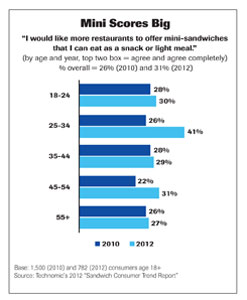In its 2012 “Sandwich Consumer Trend Report,” Technomic found consumers increasingly prefer smaller-portioned sandwiches. In 2010, about a quarter of consumers (26%) preferred to see mini-sandwiches on the menu. Today, about a third of consumers (31%) say as much.

|
Why the increased interest? For starters, smaller portions generally mean lower prices, so mini-sandwiches represent a good value to consumers looking to spend less while dining out. Further, because small-portion sandwiches cost less and can be ordered as appetizers, consumers view them as a low-risk thing to order, particularly if the sandwiches incorporate ethnic or unfamiliar flavors and ingredients. Adventurous consumers looking to expand their culinary horizons with a new type of sandwich may be hesitant to order such an item as a full-size entrée. After all, if they don’t wind up liking it, they may feel like they’re “stuck” with it. Smaller sandwiches let consumers have just a taste while spending less. They may also be perceived to be more healthful to some consumers who are looking to limit portion sizes. Finally, mini-foods, including sandwiches, are highly shareable, which gives them an inherent social element. It’s fun for a dining party to converse and bond over a shared dish, and mini-sandwiches fit the bill.
For all these reasons, mini-sandwiches are clearly appealing to consumers. With nearly one in three now expressing interest in small-size sandwiches, it is no wonder that restaurant operators are responding by beefing up their offerings accordingly.
A few recent examples:
• Mini Tri-Tip Dips—tri-tip roasted and simmered in French onion broth, topped with smoked Gouda, roasted pasilla peppers and caramelized onions on three mini-brioche buns (Claim Jumper).
• Mini Sandwich Sampler—featuring the Piña Colada Chicken Sandwich, Wild Mushroom Chicken Sandwich, Skinny Dip and BBQ Pork Sandwich (Kahunaville Island Restaurant & Party Bar).
• Beef Brisket Sliders—three mini-rolls topped with horseradish cream, crunchy mini-potato pancake, savory beef brisket and caramelized onions (TooJay’s Original Gourmet Deli).
Menu developers seeking ways to update their sandwich offerings should look to these brands for inspiration—while recognizing that mini-sandwiches represent a safe and easy way to experiment with unusual flavor combinations and pair seemingly incongruous ingredients. Kahunaville’s Mini Sandwich Sampler, for example, features chicken doused in piña colada-flavored sauce. It’s a strong example of an unexpected sandwich format featuring an unusual flavor pairing.
Flavor, health, uniqueness, value, portability and shareability are all attributes of mini-sandwiches. Innovative menu developers and their supplier partners are crafting small-bite sandwiches that play up these distinct attributes.
|
Restaurant Show Eyes Food Formulation, Nutrition |
|
Editor’s Note: The National Restaurant Association (NRA) addressed food formulation and nutrition issues in educational sessions at the 2012 Restaurant, Hotel-Motel Show. Following are session excerpts, as reported by NRA staffer Elissa Elan. |
|
The recommendation that Americans reduce their sodium intake to between 1,500-2,300mg per day is a target few can accomplish, said nutrition experts at an NRA education session titled: “Sodium and Calories: Can We Meet the Dietary Guidelines and Does this Impact Foodservice?” Leading the session were Dr. Joy Dubost, Ph.D., R.D., the NRA’s director of nutrition and healthy living; and Dr. Adam Drewnowski, director of the Nutritional Sciences Program at the University of Washington in Seattle. The two explained why so many health professionals are expressing concern. “In the United States, 68% of adults are obese or overweight,” Dubost said. “Why are we concerned about obesity and [the increased intake of] sodium? Obesity sets you up for different diseases, which obviously is a concern, and dietary sodium drives up [the potential to develop] hypertension, a risk factor for heart attacks, stroke and cardiovascular disease. That is why there is so much focus on dietary sodium.” Dubost indicated current data suggests sodium intake averages 3,400mg per day. She added that sodium is on the government’s radar right now, and lawmakers and agencies are looking at ways to monitor the public’s sodium intake. The NRA, she said, supports voluntary efforts to reduce sodium in food, but it should not be regulated through legislation. Instead, emphasis should be placed on educating consumers about nutrition. “Any approach to reducing sodium should be incremental, and education is critical,” she said. “Frankly, consumers are just not there yet. We need to place emphasis on the total diet. Singling out one nutrient is not the best approach.” Dubost offered a few suggestions to restaurateurs to reduce sodium in menu items. “Start with an inventory,” she said. “See how much salt is in your menu items. Limit your use of high-sodium seasonings and sauces. Work with your vendors to find low-sodium options.” She also suggested experimenting with flavor alternatives, like herbs and spices, and also exploring acidic, pungent and sweetness profiles. Dubost also led a separate session titled: “What’s on Our Plate: New Health & Wellness Trends.” Joining her were Sylvia Escott-Stump, president of the Academy of Nutrition & Dietetics; and Dr. Adam Brumberg, deputy director of Cornell University’s Cornell Food and Brand Lab. According to Escott-Stump, a survey conducted by her organization in 2011 found that 42% of the 754 adults questioned said they diet and exercise. She added that the study found 49% of respondents with children said they aren’t doing all they can to eat healthfully or exercise. Despite the data regarding parents and healthfulness, the study determined that children’s nutrition is significantly improved, and nutrition, on the whole, is better understood and practiced. Berries, vegetables, whole grains, low-fat, low-sugar and low-sodium foods, and omega-3 fatty acids, are among the items people are consuming with more frequency. Dubost cited the findings of the NRA’s “2012 What’s Hot Survey,” which polled 1,800 professional chefs affiliated with the American Culinary Federation (ACF). Members said the top 20 industry trends included the use of more locally sourced products, health and nutrition, and the offering of more healthful kids’ meals. The survey also found more QSR restaurants offered fruit-and-veggie sides, and low-fat or nonfat milk and 100% juices with their kids’ meals. pf |
